Gender Preference and Difference in Behavior Modeling in Fitness Applications: A Mixed-Method Approach
Abstract
1. Introduction
2. Background and Related Work
2.1. Social Cognitive Determinants of Behavior
2.1.1. Self-Efficacy
2.1.2. Self-Regulation
2.1.3. Outcome Expectation
2.2. Behavior Modeling
2.3. Gender-Based Tailoring
2.4. Research Objective and Questions
- (1)
- What preferences do users have with respect to bodyweight exercise types?
- (2)
- What are the main drivers and barriers of users’ target exercise-type preferences?
- (3)
- How does the gender of the observers of behavior models moderate users’ target exercise-type preferences, their drivers, and barriers?
- (4)
- How do the gender of the observers and their target exercise-type preference moderate their perceived self-efficacy, perceived self-regulation, outcome expectation, and projected level of performance of the target bodyweight exercise behaviors?
3. Method
3.1. Research Design
3.2. Participants
3.3. Measurement Instruments
3.4. Thematic Analysis of Participants’ Comments on Most/Least Preferred Exercise Types
4. Result
4.1. User Preferences for Bodyweight Exercise Based on Gender
4.2. Drivers and Barriers of the Most and Least Preferred Exercise Types
4.2.1. Visualization of the Drivers of the Most Preferred Exercise Types
4.2.2. Visualization of the Barriers against the Least Preferred Exercise Types
4.3. Users’ Social Cognitive Beliefs Profile
4.3.1. Reliability Analysis
4.3.2. Average Rating of Social Cognitive Constructs and Projected Exercise Performance Level
4.3.3. Main Effect and Interaction Analysis for Perceived Self-Efficacy, Perceived Self-Regulation, and Outcome Expectation
4.3.4. Main Effect and Interaction Analysis for Projected Exercise Performance Level
5. Discussion
5.1. Users’ Most Preferred Exercise Types and Their Drivers
5.1.1. Males’ Most Preferred Exercise Types and their Drivers
5.1.2. Females’ Most Preferred Exercise Types and their Drivers
5.1.3. Comparison of Users’ Most Important Drivers of Most Preferred Exercise Types to Key Determinants of Technology Acceptance Model
5.2. Users’ Least Preferred Exercise Types and their Barriers
5.2.1. Males’ Least Preferred Exercise Types and their Barriers
5.2.2. Females’ Least Preferred Exercise Types and their Barriers
5.3. Gender Similarities in Exercise-Type Preferences, Drivers, and Barriers
5.4. Gender Differences in Exercise-Type Preferences, Drivers, and Barriers
5.5. Design Guidelines for a One-Size-Fits-All Fitness App
5.6. Tailoring Based on User Gender and Exercise-Type Preference
5.6.1. Design Guidelines for a Male-Tailored Fitness App
5.6.2. Design Guidelines for a Female-Tailored Health App
5.7. Summary of Main Findings
- (1)
- Males prefer push-up the most and running in place the least. However, females prefer squat the most and push-up the least.
- (2)
- The most important drivers of both genders’ most prefer exercise types include effectiveness, ease of performance, and the improvement of the physique, look, and appearance.
- (3)
- The most important barriers against both genders’ least prefer exercise types include difficulty, pain, and hurt.
- (4)
- Males are more likely than females to perform bodyweight exercises as a result of perceived effectiveness, fun, enjoyment, and improvement of physical strength. However, females are more likely than males to perform bodyweight exercises as a result of perceived ease of performance.
- (5)
- Males are more likely than females to not perform bodyweight exercises as a result of perceived ineffectiveness and non-benefit. However, females are less likely than males to perform bodyweight exercises as a result of perceived difficulty, perceived inability, and having non-strong body parts targeted by the exercises.
- (6)
- Males are more likely than females to have higher perceived self-efficacy and higher projected performance level for bodyweight exercise, especially with regard to push-up.
5.8. The Implication of Finding and Contributions
5.9. Limitations of Findings and Future Work
6. Conclusions
Author Contributions
Funding
Conflicts of Interest
Appendix A
| Participants’ Comments based on Themes | M | F |
|---|---|---|
| 1. Exercise type is effective, useful, and beneficial - They are very effective, and I know how to do them properly [P438, PU, M]. - Crunches are one of the exercises I still incorporate (as most core exercises) since they are still effective under body weight [P97, CR, M]. - Push up is a very simple but effective workout. There are many ways to do a pushup to either target your chest, shoulders, or triceps [P415, PU, M]. - Squats are very effective since you engage your whole body and work many muscle groups [P585, SQ, F]. - I like the simplicity and effectiveness of planks and the ease of measuring progress [P268, PL, F]. - It reduces the belly and thigh fat and easy to go this workout. [P90, CR, F]. | 19.59% | 12.84% |
| 2. Exercise type is easy to perform - It is easy to do [P559, SQ, M]. - I like to do crunches because they are easy for me. [P64, CR, M]. - It is the most effective and easiest [P280, F, PL, M] - I don’t get much exercise, but squats have always been pretty easy for me [P96, SQ, F]. - Crunches are easy for me to do. They don’t feel like a lot of exercise, and they’re not hard on my back. [P177, CR, F]. - They’re easy to do, and I can withstand the pain longer [P343, PL, F] | 13.16% | 17.74% |
| 3. Physical development of body parts to improve physical appearance and looks - I like crunches because I want a nicer stomach [P59, CR, M]. - I love being able to do push-ups like a man. The added bonus is how great my arms look in a sleeveless top [P373, PU, M]. - Always love a great looking butt, and if you do it right, you can work out your core as well [P504, SQ, F]. - It helps me look better compared with all other types of activities [P30, CR, F]. - It is easy to do, and it gives you a nice looking core [P85, CR, F]. | 12.57% | 13.15% |
| 4. Development of physical (especially core) strength - I find that planks require a lot of focus, are great for core strength when performed correctly [P260, PL, F, M]. - I have weak legs and squats help strengthen them [P538, SQ, M]. - Building core strength [P240, PL, M]. - Targets the muscles I want to work on strengthening [P594, SQ, F]. - Crunches lead to the best core muscle strengthening, I think. Helps me with my posture, breathing, singing [P30, CR, F]. - Strengthens the abs and works your whole body [P305, PL, F]. | 10.53% | 5.50% |
| 5. Exercise type is users’ favorite or liked by them - Planks are my favorite workout as they work your entire body and core to exhaustion [P299, PL, M]. - This is simply one of my favorite exercises [P41, SQ, M]. - I enjoy push-ups because they target my favorite muscle groups [P381, PU, M]. - I like crunches, and ab workouts are typically my favorites [P135, CR, F]. - I like doing squats, they work my butt, but also I feel it gets my heart rate going [P76, SQ, F]. | 7.89% | 6.73% |
| 6. Familiarity with an exercise type - A rewarding workout with which I have lots of experience [P321, PU, M]. - Something I grew up with, most people did. The others are part of workout routines [P434, PU, M]. - I like doing push-ups, and I have been doing them since childhood [P362, PU, M]. - I already do planks and like them the most [P156, PL, F]. - It is the current exercise I do almost daily. [P247, PU, F]. | 8.77% | 4.59% |
| 7. Exercise type targets multiple muscle groups - It works many muscles and helps body structure [P204, PU, M]. - Because it’s a compound exercise that hits most of the muscles [P37, SQ, M]. - Squats are very effective since you engage your whole body and work many muscle groups [P585, SQ, F]. - It works many different muscles at once [P324, LU, F]. | 6.73% | 5.20% |
| 8. Exercise type is convenient to do, especially anywhere outside the gym - It is easy, simple, and you can do it anywhere [P86, CR, M] - It can be done anywhere and help overall movement in day to day settings [P578, SQ, M]. - Planking is something that looks rather simple and can be done really anywhere [P295, PL, M]. - It is the easiest to do no matter what you have going on in your life or where you are [P562, SQ, F]. - I can do this exercise almost anywhere [P524, SQ, F]. - The easiest and most convenient to do [P100, CR, F]. | 4.68% | 4.59% |
| 9. Exercise type is fun and enjoyable - I enjoy doing lower body exercises, and squats work every muscle group in the legs [P28, SQ, M]. - It is fun [P87, CR, M] - Planks are a great core workout I really enjoy [P296, PL, M]. - It’s the most enjoyable and not as painful in comparison to others [P569, SQ, F]. - I enjoy crunches the most and think they target an area that needs work on my body [P47, CR, F]. - They feel the most satisfying and help core muscles get stronger [P311, PL, F]. | 5.56% | 2.75% |
| 10. Ability to do exercise type - I feel I can do a lot [P124, SQ, M]. -It is a fun activity that I used to do as a kid. Now, I can do them to help me stay in shape [P192, JJ, M]. -I am the best at this exercise, and I like core workouts the best [P242, PL, F]. - I am good at them, and they work out where I want to focus the most [P344, SQ, F]. | 1.46% | 4.28% |
| 11. Exercise type engages or works out the whole body - It is a full-body workout, and they just feel really good to do [P557, SQ, M]. - Planks are my favorite workout as they work your entire body and core to exhaustion [P299, PL, M]. - Those kinds of exercise influence all body, not only certain muscles [P326, PL, F] - Strengthens the abs and works your whole body [P305, PL, F]. | 3.22% | 1.83% |
| 12. Exercise type facilitates fat and calorie burn and/or weight loss - I prefer doing crunches because it helps to reduce stomach fat faster [P73, CR, M]. - I need to lose the fat in my abs [P71, CR, M]. - It helps to reduce belly fat, which is the problem of many people [P277, PL, M]. - It reduces the belly and thigh fat and easy to go this workout [P89, CR, F] - I know crunches will help me lose some of my belly fat and help tone my abdominal muscles [P55, CR, F] - I would like to reduce my belly fat [P77, CR, F] | 1.46% | 3.67% |
| 13. Provision of cardio benefit - Push-ups provide cardio and strength in an exercise [P423, PU, M]. - I have found they are effective for building strength and are decent as a cardio workout as well[P203, SQ, M]. - It strengthens all your core muscles as well as raises your heart rate for a good cardiovascular workout [P282, PL, M]. - I like doing squats, they work my butt, but also I feel it gets my heart rate going [P540, SQ, F]. - A very simple warm-up and cardio exercise [P149, Jumping, Jacks, F]. | 1.75% | 2.45% |
| 14. Muscle building and stretching - Increases muscle size in the chest and arm region [P389, PU, M]. - Push-ups are good for building several groups of upper core muscles [P418, PU, M]. - I need to recover that upper body mass I lost after I stopped getting much exercise and got flabby [P378, PU, M]. -I am more willing to build my core [P401, CR, F]. - I like lunges, as they work more and larger muscles. [P410, LU, F]. | 2.63% | 1.53% |
| 15. Quick to do and fast result - When doing them before, the seemed to work the very fastest [P19, CR, M]. - I prefer doing crunches because it helps to reduce stomach fat faster [P73, CR, M]. - It’s the most simple, and it quickly works my muscles [P290, PL, M]. - Because I can see results quicker [P21, CR, F]. - I do planks when I let my dog out to pee. They are quick and easy and can be done anywhere, including in front of the door [P256, PL, F]. | 1.46% | 1.53% |
| 16. Exercise type is challenging - It is the most physically demanding out of all of them [P282, PU, M]. - They are the biggest challenge for me [P545, PU, M]. - This uses a lot of muscles and teaches you to balance. It’s very challenging and beneficial. [P504, SP, F]. -Side planks are difficult for me. I like a challenge. [P166, SP, F]. | 1.75% | 1.22% |
| 17. Exercise type makes users be in shape and fit -Push-ups make me strong and stay in shape [P119, PU, M]. -It is a fun activity that I used to do as a kid. Now, I can do them to help me stay in shape [P192, JJ, M]. -I am out of shape, and that would be an easier start [P405, JJ, F]. - My thighs/legs are not in good shape, so I think squats are the exercise that I most need to do. [P81, SQ, F]. | 0.58% | 1.53% |
| 18. No tool or equipment required to perform exercise type - No extra tools, I already know how to do it [P96, CR, M]. - Push-ups are a naturally well-structured exercise, which focuses on multiple muscle areas without the use of any extra mass, [P291, PU, M]. - It can be done anywhere, doesn’t require any equipment, and you have to be stationary to perform it correctly [P241, PL, F]. - I could do this without having any special exercise gear or equipment. [P264, Step-Ups, F]. | 1.75% | 0.31% |
| 19. Variability and adaptability of exercise type - St[r]ong, compound movement. Works large chains of muscles, while staying scalable and having many varieties [P592, SQ, M] - You can also mix and match many different styles for added difficulty and challenge [P282, PL, M]. - Squats are very versatile, there are different ways of doing them, and you can add weights to squats. [P586, SQ, F] - It is the easiest, but variations like using a ball against the wall should be shown too [P563, SQ, F]. | 1.17% | 0.92% |
| 20. Exercise type is less hurtful, painful, and stressful - I feel it gives the most benefit in the places that I most want to be strengthened, and puts the least amount of stress on my body [P193, LU, M]. - I find this workout less stressful than the others [P644, WS, M]. - The least strain on my back [P351, Step-Ups, F]. - It hurts the least (in the muscles) [P498, RIP, F]. | 0.88% | 1.22% |
| 21. Exercise type can be combined with other tasks and activities - Already have strong legs, easy to do in one place while also watching/doing something else [P50, SQ, M]. - They’re effective, but I can also do other things [P313, PL, F]. | 0.58% | 0.92% |
| 22. It is comfortable doing exercise type - It is the most comfortable to perform [P191, Crunch, M]. - It doesn’t put any stress on my shoulder or knee [P166, CR, F]. - I’ve done all of these before, but squats are what I am most comfortable with [P252, SQ, F]. - I like crunches because they’re the most comfortable to do, and, as a result, I do most of those [P398, CR, F]. | 0.29% | 1.53% |
| Participants’ Comments based on Themes | M | F |
|---|---|---|
| 1. Exercise type is difficult, hard, and challenging - I already have a tough time doing push-ups, so another step makes it more difficult [P43, PR, M]. - I am 72 years old, and even though I am in good shape, the push-up with rotation exercise would be too difficult for me [P17, PR, M]. - The wall sit is a little difficult to balance [P96, WS, M]. - Push-ups are incredibly difficult, in my personal opinion, so I would prefer not to do them if possible[P400, PU, F]. - I find them exceptionally difficult [P384. PU, F]. - Doing lunges is hard because my muscles burn [P54, LU, F]. | 16.96% | 27.22% |
| 2. Exercise type is painful, hurtful, and stressful -I dislike them because they hurt my knees. [P4, LU, M]. -I never feel like I do these right, and they hurt my elbow and back [P16, SP, M]. - It puts a lot of stress on my arm. I don’t really need that. [P18, SP, M]. - This causes a lot of pain in my wrists because I have broken one before [P357, PU, F]. - It is kind of painful for me, and I have zero arm strength. Before push-ups, I’d need to work on my limbs [P373, PU, F]. - It hurts my arms a lot [P375, PU, F]. | 12.87% | 14.98% |
| 3. Weak and lack of strong body parts required for exercise type -I have weak core strength and fin that they strain my neck [P99, CR, M]. -I do not have much upper body strength making it very challenging [P188, PU, M]. - I have terrible, weak arms and have always disliked doing this exercise [P368, PU, F]. - I have zero arm strength and always struggle with push-ups. [P395, PU, F]. - I lack the arm strength to do proper, regular push-ups [P387, PU, F]. - I don’t have much upper body strength [P399, PU, F]. | 4.68% | 16.82% |
| 4. Exercise type is ineffective and non-beneficial - It’s not effective [P202, RIP, M]. - Boring and ineffective. I’d rather run for real [P277, RIP, M]. - It honestly seems like the most useless exercise in the world [P238, RIP, F]. - Running in place doesn’t do anything for me. It doesn’t seem like a workout. I’m not really feeling the sweat by running in place. I prefer to use the treadmill or run outside [P192, RIP, F]. | 13.45% | 6.73% |
| 5. Exercise type is boring, not fun, and enjoyable - Too boring! I would rather go running outside like I already do! [P195, RIP, M]. -Wall sit requires a wall, and it’s pretty boring. [P105, WS, M]. - I find such activities rather mundane, and get bored quickly when I do them [P195, RIP, M]. - It is boring to me; I would much rather go on a run outside or at the gym [P195, RIP, F]. - I don’t enjoy pushup, and that looks even more unenjoyable. [P86, PR, F]. - It is boring and would hurt my joints more [P200, RIP, F]. | 7.02% | 7.34% |
| 6. Dislike exercise type -I hate running in place [P20, RIP, M]. -I don’t like running. I’ve never liked it [P301, RIP, M]. -I dislike them because they hurt my knees. [P4, LU, M]. -I do not like to do Jumping Jacks. They do not appeal to me [P239, JJ, F]. - I have terrible, weak arms and have always disliked doing this exercise [P322, PU, F]. - I don’t like doing things with my arms [P486, PR, F]. | 4.97% | 5.50% |
| 7. Inability to perform exercise type -I’ve never been able to successfully do them [P527, PU, M]. -I can’t do them as I am not strong enough [P638, PU, M]. -I cannot do them due to my shoulder and carpal tunnel. [P85, PL, F]. - I can’t do them well [P151, PU, F]. | 1.46% | 8.26% |
| 8. Exercise type is better outdoor or on the treadmill - I am not a fan of running in place. I prefer using a treadmill or running outside [P188, RIP, M]. - I’m not really feeling the sweat by running in place. I prefer to use the treadmill or run outside [P195, RIP, M]. - I would rather prefer to run outside than standing at a place [272, RIP, M]. - I’d prefer to run outside and travel somewhere for that kind of exercise [P204, RIP, F]. - It just sounds boring. If I am going to run, I prefer to be outside [P186, RIP, F]. - I find it boring, basic. If I wanted to run I would rather go on a treadmill or go outside [P270, RIP, F]. | 6.14% | 3.36% |
| 9. Exercise type requires equipment and/or space - Where do I get such a wall in my house [P462, WS, M]? - It requires too much equipment [P206, SU, M]. -Have limited space to perform certain exercises [P126, PR, M]. - they’re extremely boring and need too much space to complete [P148, LU, F]. -Difficult to do and find the right equipment to ensure stability [P142, CD, F]. - I would have to go find a box that would be suitable for this exercise [P67, SU, F]. | 2.92% | 3.98% |
| 10. Exercise type is not comfortable to do - Feels awkward and not as effective as regular running [P251, RIP, M]. -Very uncomfortable to do [P202, PL, M]. - Push-ups just make me uncomfortable, and they are very straining [P63, PU, F]. - I think it’s very awkward and uncomfortable [P177, RIP, F]. | 2.92% | 3.36% |
| 11. Exercise type is disruptive to neighbors - Itcan be noisy for neighbors [P88, JJ, M]. - It is noisy, plus if I run, I rather run on a treadmill, which is easier on my knee or outside where the view is nice [P218, RIP, M]. - I like in an apartment, so I can’t be jumping up and down. I also don’t find it a very beneficial exercise [P610, JJ, M]. - I live in an apartment and do not want to disturb people under me [P571, RIP, F]. - it makes too much noise at home and makes me feel like I’m in PE class [P660, JJ, F]. | 1.17% | 0.61% |
| 12. Exercise type is unfamiliar -I don’t know what chair dips are, so that is why I chose them for least preferred [P7, CD, M]. - This is uncommon, I’ve never done it before, I don’t want to learn a whole new thing, invest the time, etc [P606, PR, M]. - This is the first time I heard about this [P588, WS, F]. | 1.17% | 0.31% |
| 13. Exercise type is not challenging - It’s monotonous, there is not much resistance in this exercise for muscle and bone strength increase, and because there is less work done by muscles, there is less cardiovascular activity as well [P207, RIP, M]. - Running in place is too easy for me. I like the challenge [P261, RIP, F]. | 0.29% | 0% |
References
- Bandura, A. Social Cognitive Theory of Mass Communication. In Media Effects: Advances in Theory and Research; Bryant, J., Zillman, D., Eds.; Lawrence Erlbaum: Hillsdale, NJ, USA, 2001. [Google Scholar] [CrossRef]
- Abraham, C.; Michie, S. A taxonomy of behavior change techniques used in interventions. Heal. Psychol. 2008, 27, 379–387. [Google Scholar] [CrossRef] [PubMed]
- Van Uffelen, J.; Khan, A.; Burton, N.W. Gender differences in physical activity motivators and context preferences: A population-based study in people in their sixties. BMC Public Health 2017, 17, 624. [Google Scholar] [CrossRef] [PubMed]
- Thompson, W.R. Worldwide survey of fitness trends for 2017. ACSM’s Health Fit. J. 2016, 20, 8–17. [Google Scholar] [CrossRef]
- Conroy, D.E.; Yang, C.-H.; Maher, J.P. Behavior Change Techniques in Top-Ranked Mobile Apps for Physical Activity. Am. J. Prev. Med. 2014, 46, 649–652. [Google Scholar] [CrossRef]
- Bandura, A. Social Foundations of Thought and Action: A Social Cognitive Theory; Prentice-Hall: Englewood Cliffs, NJ, USA, 1986. [Google Scholar]
- Rovniak, L.S.; Anderson, E.S.; Winett, R.A.; Stephens, R.S. Social cognitive determinants of physical activity in young adults: A prospective structural equation analysis. Ann. Behav. Med. 2002, 24, 149–156. [Google Scholar] [CrossRef]
- Oyibo, K. Designing Culture-Based Persuasive Technology to Promote Physical Activity among University Students. In Proceedings of the 24th Conference on User Modeling, Adaptation and Personalization (UMAP 2016), Halifax, NS, Canada, 13–16 July 2016; pp. 321–324. [Google Scholar] [CrossRef]
- Yoganathan, D.; Sangaralingam, K. Persuasive Technology for Smartphone Fitness. In Proceedings of the PACIS 2013, Jeju Island, Korea, 18–22 June 2013; pp. 1–11. Available online: http://aisel.aisnet.org/pacis2013/185 (accessed on 21 May 2020).
- Bandura, A. Health Promotion by Social Cognitive Means. Health Educ. Behav. 2004, 31, 143–164. [Google Scholar] [CrossRef]
- Yoganathan, D. Designing Fitness Apps Using Persuasive Technology: A Text Mining Approach. In Proceedings of the PACIS, Singapore, 5–9 July 2015; p. 40. [Google Scholar]
- Passion 4 Profession. Professional Video Tutorials. 2016. Available online: http://passion4profession.net/p4p/home (accessed on 11 November 2016).
- Lin, C.-Y.; Chen, Y.-S.; Tsai, J.-C. Exploring the Triple Reciprocity of Information System Psychological Attachment. In Future Information Technology; Springer: Berlin/Heidelberg, Germany, 2014; pp. 779–785. [Google Scholar]
- Oyibo, K.; Vassileva, J. Persuasive Features that Drive the Adoption of a Fitness Application and the Moderating Effect of Age and Gender. Multimodal Technol. Interact. 2020, 4, 1–17. [Google Scholar]
- Stibe, A. Socially Influencing Systems: Persuading People to Engage with Publicly Displayed Twitter-Based Systems; Acta Universitatis Ouluensis, 2014. Available online: http://urn.fi/urn:isbn:9789526205410 (accessed on 21 May 2020).
- Fogg, B.J. Persuasive Technology: Using Computers to Change What We Think and Do; Morgan Kaufmann: Burlington, MA, USA, 2003. [Google Scholar]
- Bandura, A. Self-Efficacy: The Exercise of Control. Choice Reviews Online; W. H. Freeman: New York, NY, USA, 1997; Volume 35. [Google Scholar] [CrossRef]
- Schwarzer, R.; Aleksandra, L. Perceived Self-Efficacy. In Health Behavior Constructs: Theory, Measurement, and Research; National Cancer Institute: Bethesda, MD, USA, 2007; pp. 1–33. [Google Scholar]
- Oyibo, K.; Orji, R.; Vassileva, J. Developing Culturally Relevant Design Guidelines for Encouraging Physical Activity: A Social Cognitive Theory Perspective. J. Healthc. Inform. Res. 2018, 1–34. [Google Scholar] [CrossRef]
- Oyibo, K.; Adaji, I.; Vassileva, J. Social cognitive determinants of exercise behavior in the context of behavior modeling: A mixed method approach. Digit. Heal. 2018, 4. [Google Scholar] [CrossRef]
- Bandura, A. Social cognitive theory of self-regulation. Organ. Behav. Hum. Decis. Process. 1991, 50, 248–287. [Google Scholar] [CrossRef]
- Wójcicki, T.; White, S.M.; McAuley, E. Assessing Outcome Expectations in Older Adults: The Multidimensional Outcome Expectations for Exercise Scale. J. Gerontol. Ser. B 2009, 64, 33–40. [Google Scholar] [CrossRef] [PubMed]
- Vollmer, J.; Patrick, S.; Manuel, G. Plank Challenge with NAO: Using a Robot to Persuade Humans to Exercise Longer. In Alexander Meschtscherjakov Boris De Ruyter Verena Fuchsberger Martin Murer; Springer: Berlin, Germany, 2016. [Google Scholar]
- Ellis, T.; Latham, N.K.; DeAngelis, T.R.; Thomas, C.A.; Saint-Hilaire, M.-H.; Bickmore, T.W. Feasibility of a virtual exercise coach to promote walking in community-dwelling persons with Parkinson disease. Am. J. Phys. Med. Rehabil. 2013, 92, 472–485. [Google Scholar] [CrossRef] [PubMed]
- Abdullahi, A.M.; Orji, R.; Oyibo, K. Vastenburg. Flowie: A persuasive virtual coach to motivate elderly individuals to walk. In Proceedings of the 2009 3rd International Conference on Pervasive Computing Technologies for Healthcare, London, UK, 1–3 April 2009; pp. 1–7. [Google Scholar]
- Watson, A.J.; Bickmore, T.; Cange, A.; Kulshreshtha, A.; Kvedar, J.; Hurling, R.; Bexelius, C.; Slinde, F. An Internet-Based Virtual Coach to Promote Physical Activity Adherence in Overweight Adults: Randomized Controlled Trial. J. Med. Internet Res. 2012, 14, e1. [Google Scholar] [CrossRef] [PubMed]
- Oyibo, K.; Adaji, I.; Orji, R.; Olabenjo, B.; Azizi, M.; Vassileva, J. Perceived Persuasive Effect of Behavior Model Design in Fitness Apps. In Proceedings of the 26th Conference on User Modeling, Adaptation and Personalization, Singapore, 8–11 July 2018; pp. 219–228. [Google Scholar]
- Abdullahi, A.M.; Orji, R.; Oyibo, K. Personalizing Persuasive Technologies: Do Gender and Age Affect Susceptibility to Persuasive Strategies? In Proceedings of the Adjunct Publication of the 26th Conference on User Modeling, Adaptation and Personalization, Singapore, 8–11 July 2018; pp. 329–334. [Google Scholar]
- Dittmar, H.; Long, K.; Meek, R. Buying on the Internet: Gender Differences in On-line and Conventional Buying Motivations. Sex Roles 2004, 50, 423–444. [Google Scholar] [CrossRef]
- Azevedo, M.R.; Araújo, C.L.P.; Reichert, F.F.; Siqueira, F.V.; Da Silva, M.C.; Hallal, P.C. Gender differences in leisure-time physical activity. Int. J. Public Health 2007, 52, 8–15. [Google Scholar] [CrossRef]
- Lumen. The Social Construction of Gender; Lumen: Tysons, VA, USA, 2017; Available online: https://courses.lumenlearning.com/cochise-sociology-os/chapter/the-social-construction-of-gender/ (accessed on 21 May 2020).
- World Health Organization. Global Recommendations on Physical Activity for Health; World Health Organzation: Geneva, Switzerland, 2010; Available online: http://www.who.int/dietphysicalactivity/factsheet_recommendations/en/ (accessed on 21 May 2020).
- Oyibo, K.; Vassileva, J.; De Vries, P.W.; Oinas-Kukkonen, H.; Siemons, L.; Jong, N.B.-D.; Van Gemert-Pijnen, L. Investigation of Social Predictors of Competitive Behavior in Persuasive Technology. In Proceedings of the 12th International Conference on Persuasive Technology (PT’17), Amsterdam, The Netherlands, 4–6 April 2017. [Google Scholar] [CrossRef]
- Oyibo, K.; Orji, R.; Vassileva, J. Investigation of the Persuasiveness of Social Influence in Persuasive Technology and the Effect of Age and Gender. In International Workshop on Persuasive Technology; CEUR: Amsterdam, The Netherlands, 2017. [Google Scholar]
- Cyr, D.; Bonanni, C. Gender and website design in e-business. Int. J. Electron. Bus. 2005, 3, 565. [Google Scholar] [CrossRef]
- Drozd, F.; Lehto, T.; Oinas-Kukkonen, H. Exploring perceived persuasiveness of a behavior change support system: A structural model. In Proceedings of the International Conference on Persuasive Technology, Linköping, Sweden, 6–8 June 2012; pp. 157–168. [Google Scholar]
- Vassileva, K.; Ali, Y.S.; Vassileva, J. Gender difference in the credibility perception of mobile websites: A mixed method approach. In Proceedings of the 2016 Conference on User Modeling Adaptation and Personalization, Halifax, NS, Canada, 13–16 July 2016; pp. 75–84. [Google Scholar]
- Rushton, A.; Gray, L.; Canty, J.; Blanchard, K. Beyond Binary: (Re)Defining “Gender” for 21st Century Disaster Risk Reduction Research, Policy, and Practice. Int. J. Environ. Res. Public Health 2019, 16, 3984. [Google Scholar] [CrossRef]
- MacCarthy, S.; Reisner, S.L.; Nunn, A.; Perez-Brumer, A.; Operario, N. The Time Is Now: Attention Increases to Transgender Health in the United States but Scientific Knowledge Gaps Remain. LGBT Health 2015, 2, 287–291. [Google Scholar] [CrossRef]
- Frederick, D.A.; Fessler, D.; Haselton, M.G. Do representations of male muscularity differ in men’s and women’s magazines? Body Image 2005, 2, 81–86. [Google Scholar] [CrossRef]
- Ridgeway, R.T.; Tylka, T.L. College Men’s Perceptions of Ideal Body Composition and Shape. Psychol. Men Masculinities 2005, 6, 209–220. [Google Scholar] [CrossRef]
- Meschtscherjakov, A.; Gärtner, M.; Mirnig, A.; Rödel, C.; Tscheligi, M. The Persuasive Potential Questionnaire (PPQ): Challenges, Drawbacks, and Lessons Learned. In Proceedings of the International Conference on Persuasive Technology, Salzburg, Austria, 5–7 April 2016; Springer: Berlin/Heidelberg, Germany; pp. 162–175. [Google Scholar] [CrossRef]
- Peters, G. Userfriendlyscience: Quantitative Analysis Made Accessible. R Package Version 0.3-0. 2015. Available online: http://userfriendlyscience.com (accessed on 21 May 2020).
- Oyibo, K.; Ali, Y.S.; Vassileva, J. An empirical analysis of the perception of mobile website interfaces and the influence of culture. In Proceedings of the CEUR Workshop, Salzburg, Austria, 5 April 2016; pp. 44–56. [Google Scholar]
- Dunn, T.J.; Baguley, T.; Brunsden, V.; Baguley, T. From alpha to omega: A practical solution to the pervasive problem of internal consistency estimation. Br. J. Psychol. 2013, 105, 399–412. [Google Scholar] [CrossRef] [PubMed]
- Wobbrock, J.O.; Leah, F.; Darren, G.; Higgins, J.J. The Aligned Rank Transform for Nonparametric Factorial Analyses Using Only ANOVA Procedures. In Proceedings of the 2011 Annual Conference on Human Factors in Computing Systems-CHI ’11, Vancouver, BC, Canada, 7–12 May 2011. [Google Scholar] [CrossRef]
- Davis, F.D. Perceived Usefulness, Perceived Ease of Use, and User Acceptance of Information Technology. MIS Q. 1989, 13, 319. [Google Scholar] [CrossRef]
- Van Der Heijden, H. Factors influencing the usage of websites: The case of a generic portal in The Netherlands. Inf. Manag. 2003, 40, 541–549. [Google Scholar] [CrossRef]
- Oyibo, K.; Vassileva, J. HOMEX: Persuasive Technology Acceptance Model and the Moderating Effect of Culture. Front. Comput. Sci. 2020, 2, 1–17. [Google Scholar] [CrossRef]
- Bandura, A. Self-Efficacy. In Encyclopedia of Human Behavior; Ramachaudran, V.S., Ed.; Academic Press: Cambridge, MA, USA, 1994; pp. 71–81, (Reprinted in Friedman, H., Ed.; Encyclopedia of Mental Health; Academic Press: Cambridge, MA, USA, 1998). [Google Scholar]
- Orji, R.; Mandryk, R.L. Developing culturally relevant design guidelines for encouraging healthy eating behavior. Int. J. Hum. Comput. Stud. 2014, 72, 207–223. [Google Scholar] [CrossRef]
- MacLellan, G.; Baillie, L.; Granat, M. The Application of a Physical Activity and Location Measurement System to Public Health Interventions to Promote Physical Activity. In Proceedings of the 2nd International Conference on PErvsive Technologies Related to Assistive Environments-PETRA ’09, Corfu, Greece, 9–13 June 2009; pp. 1–8. [Google Scholar] [CrossRef]
- World Health Organization. Noncommunicable Diseases and Their Risk Factors. Available online: https://www.who.int/ncds/prevention/physical-activity/inactivity-global-health-problem/en/ (accessed on 21 May 2020).
- Oyibo, K.; Olagunju, A.-H.; Olabenjo, B.; Adaji, I.; Vassileva, J. BEN’FIT: Design, Implementation and Evaluation of a Culture-Tailored Fitness App. In Proceedings of the Adjunct Publication of the 27th Conference on User Modeling, Adaptation and Personalization, Larnaca, Cyprus, 9–12 June 2019. [Google Scholar]
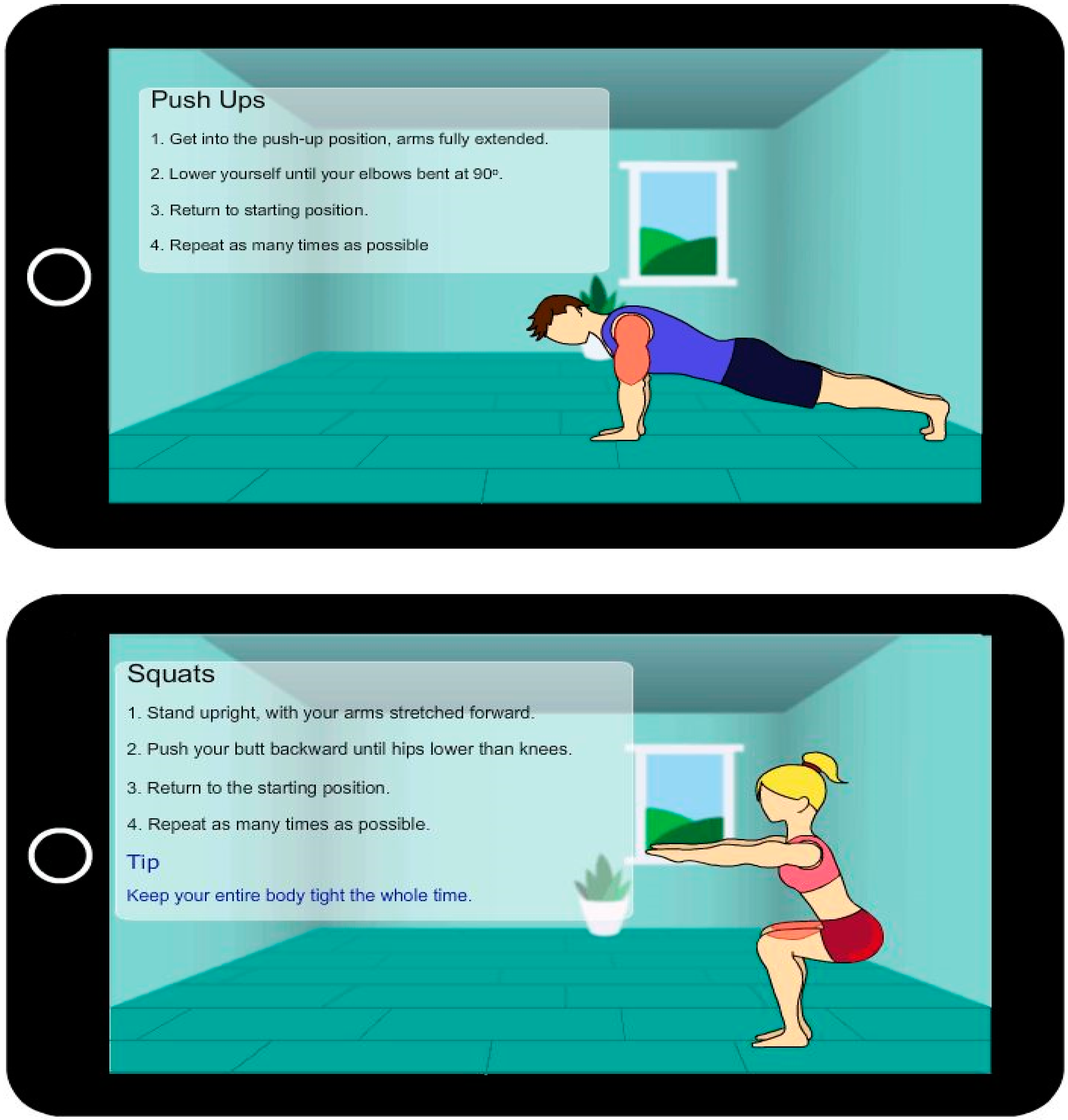
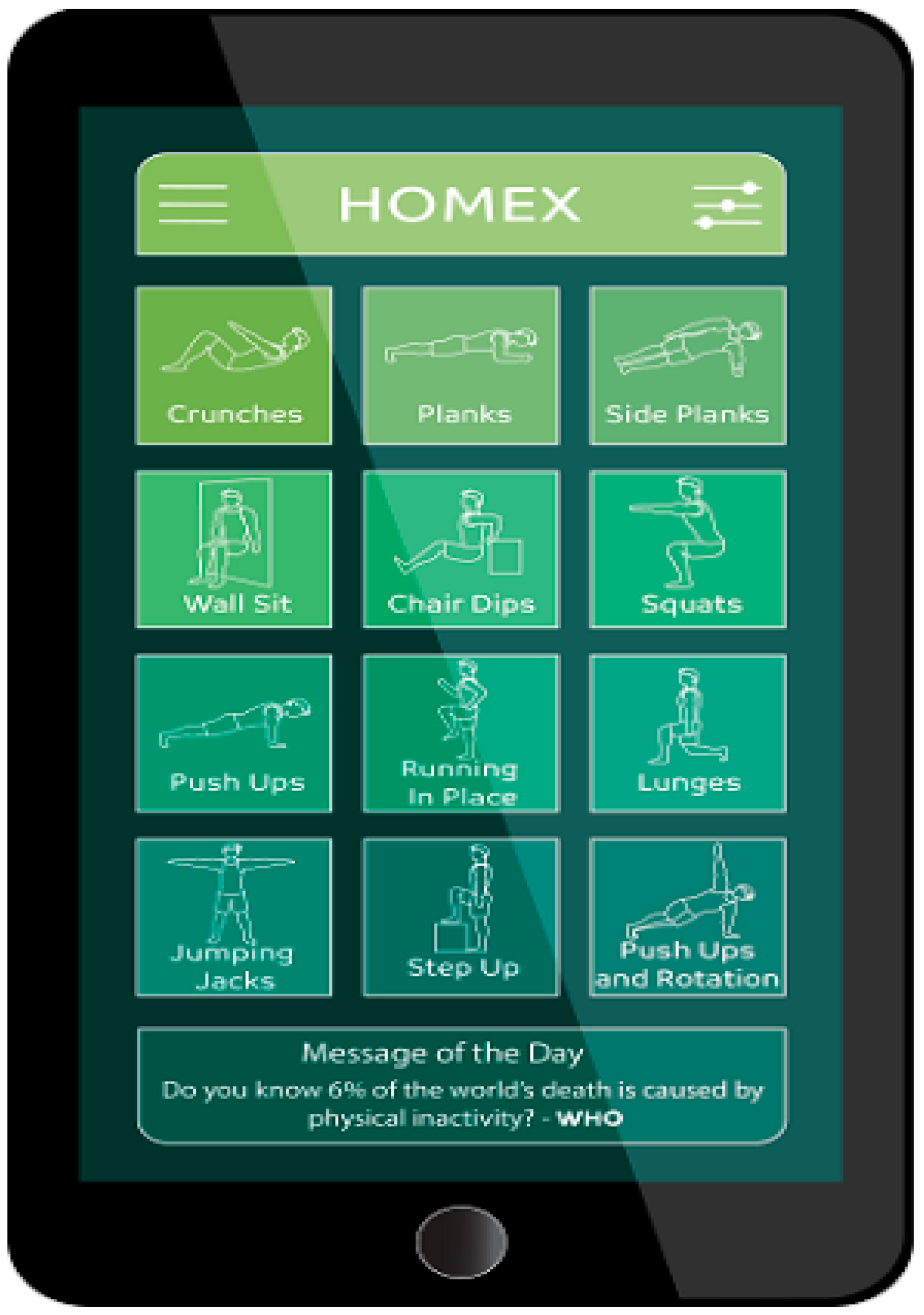
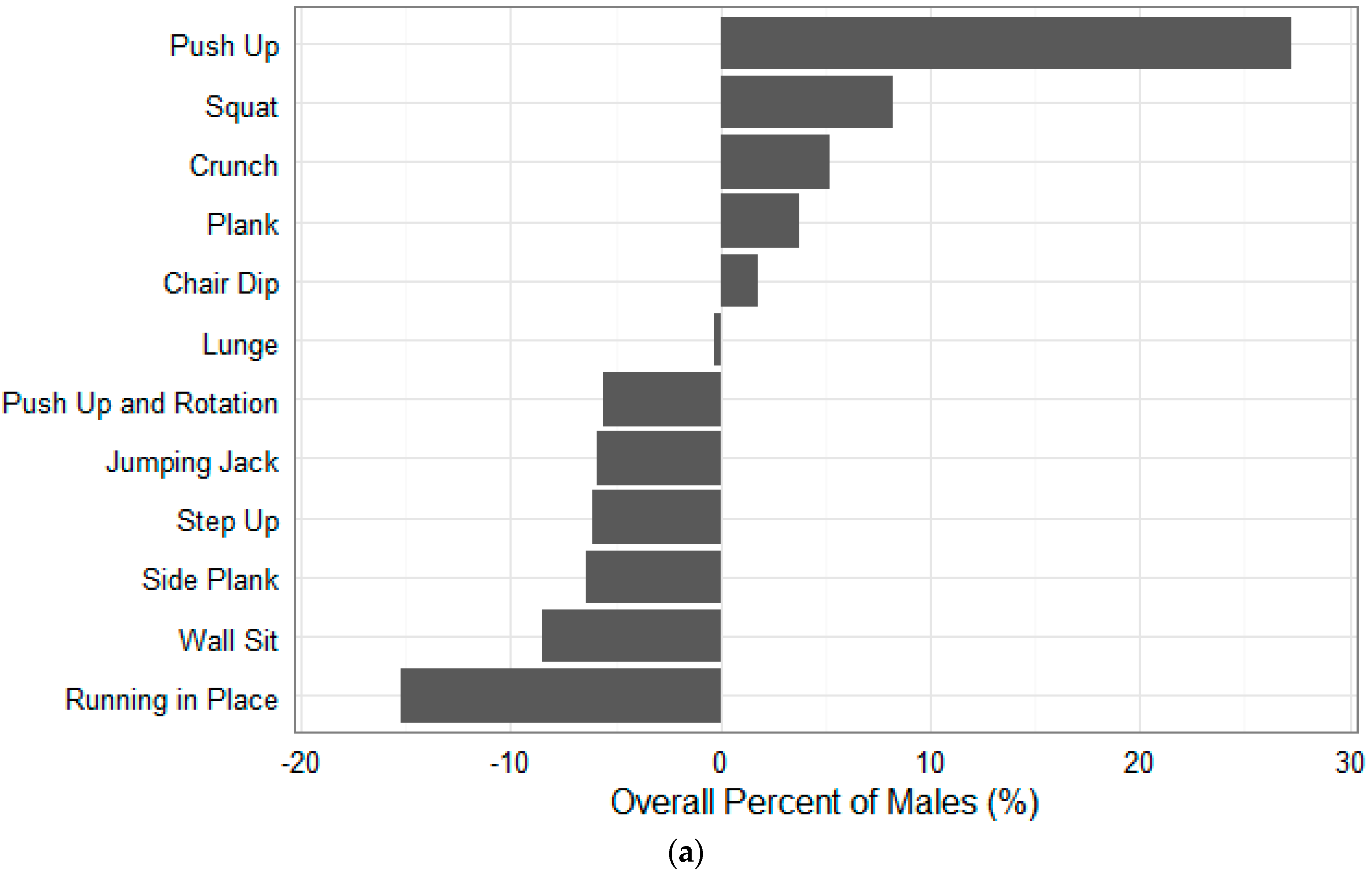
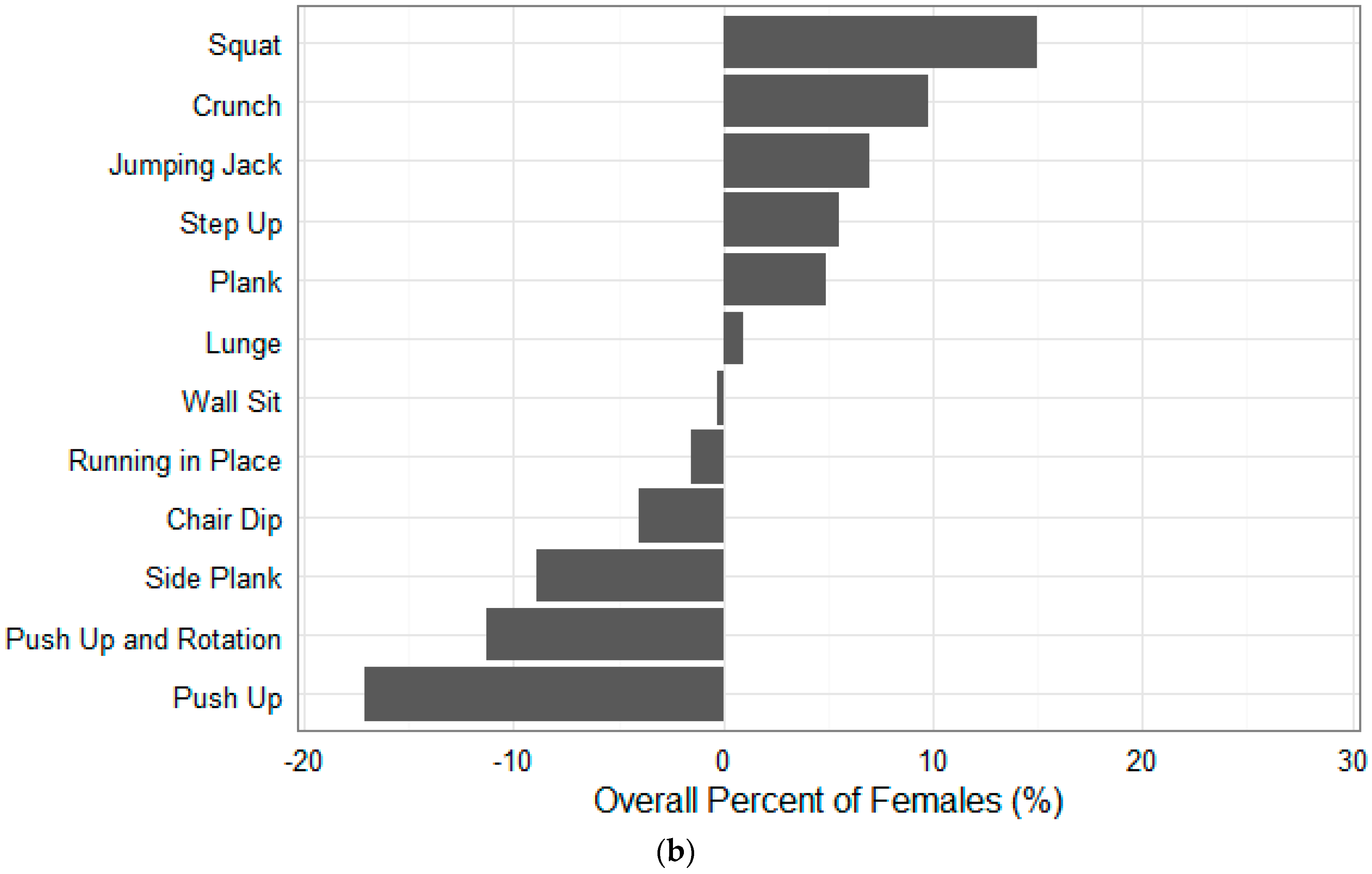
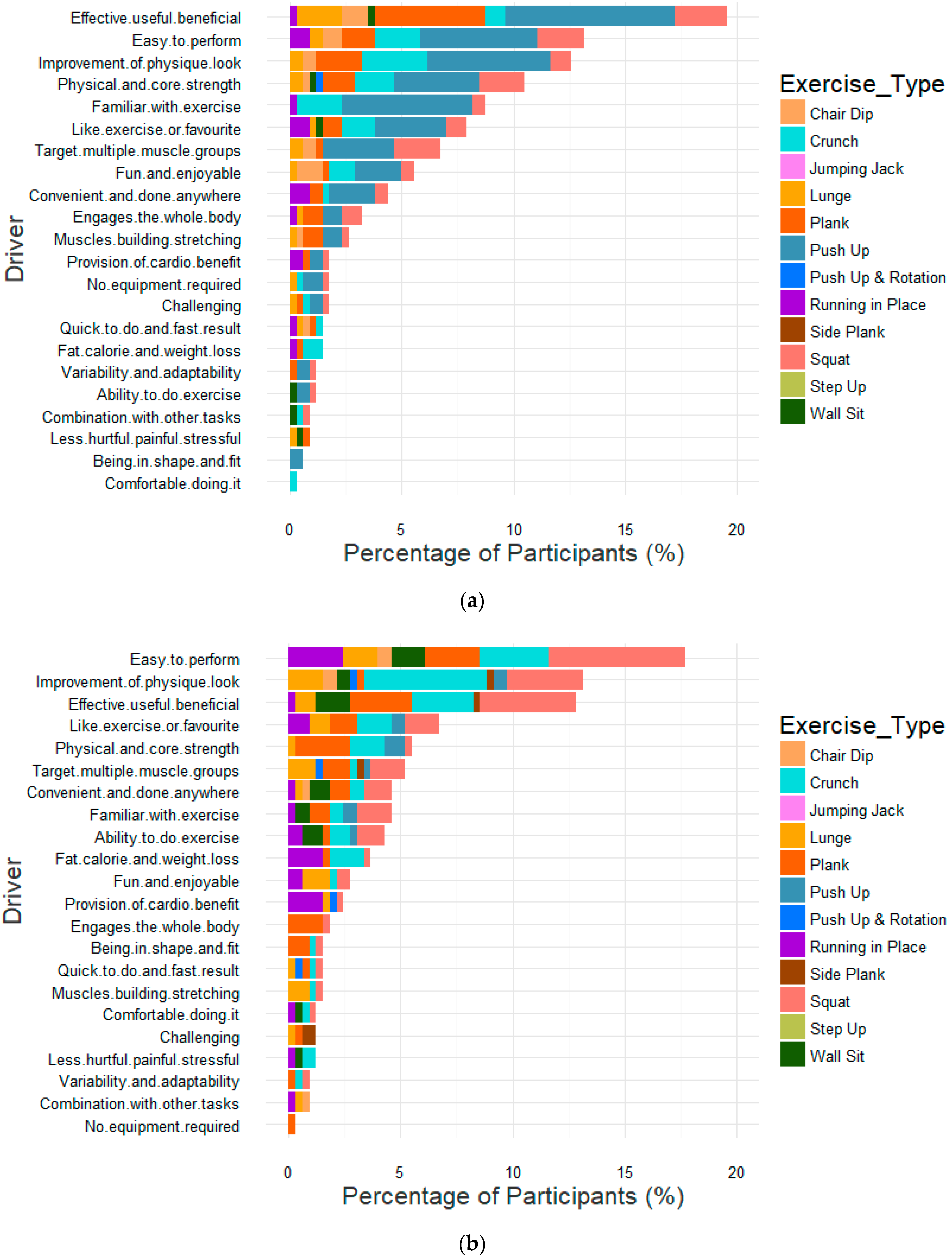
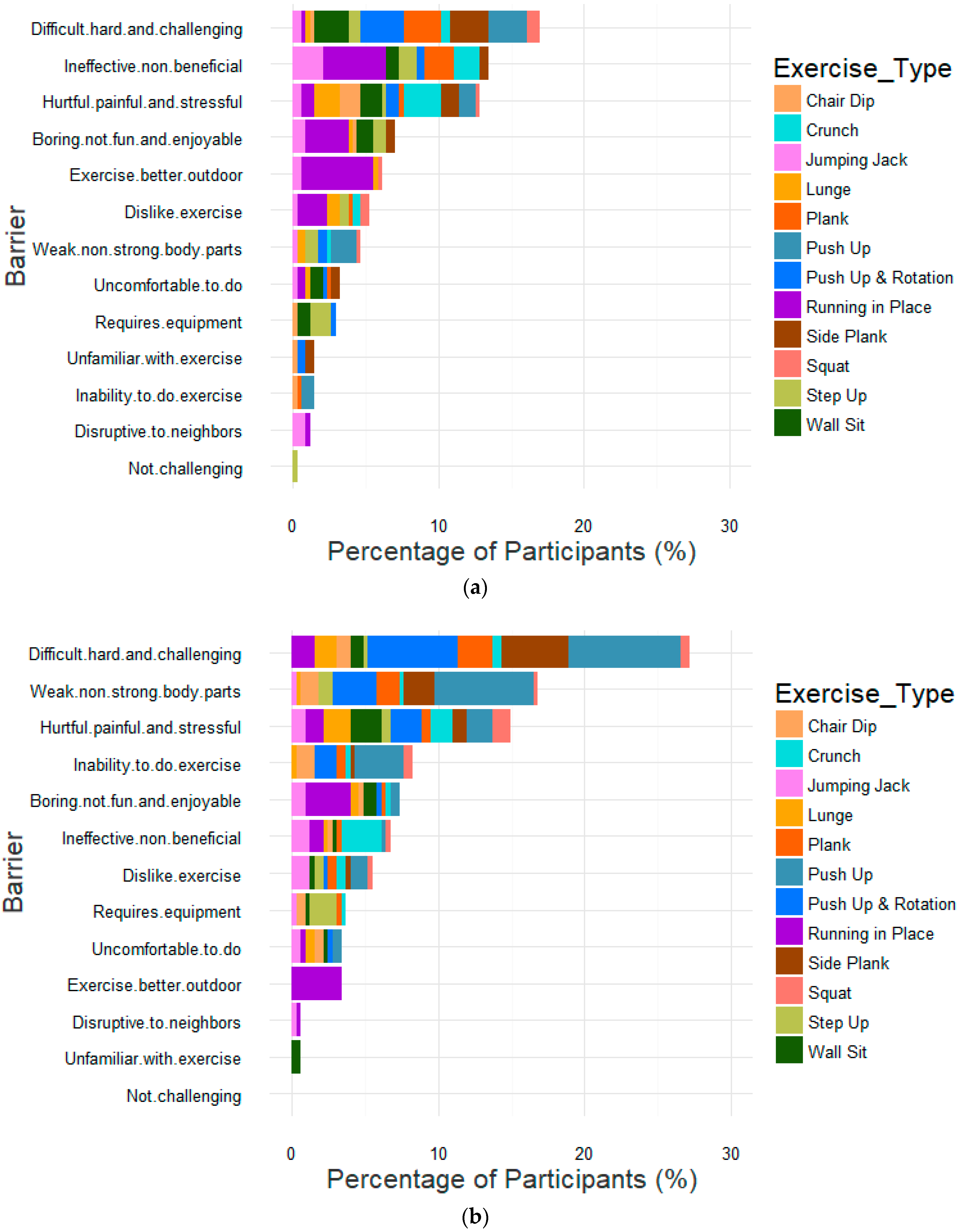
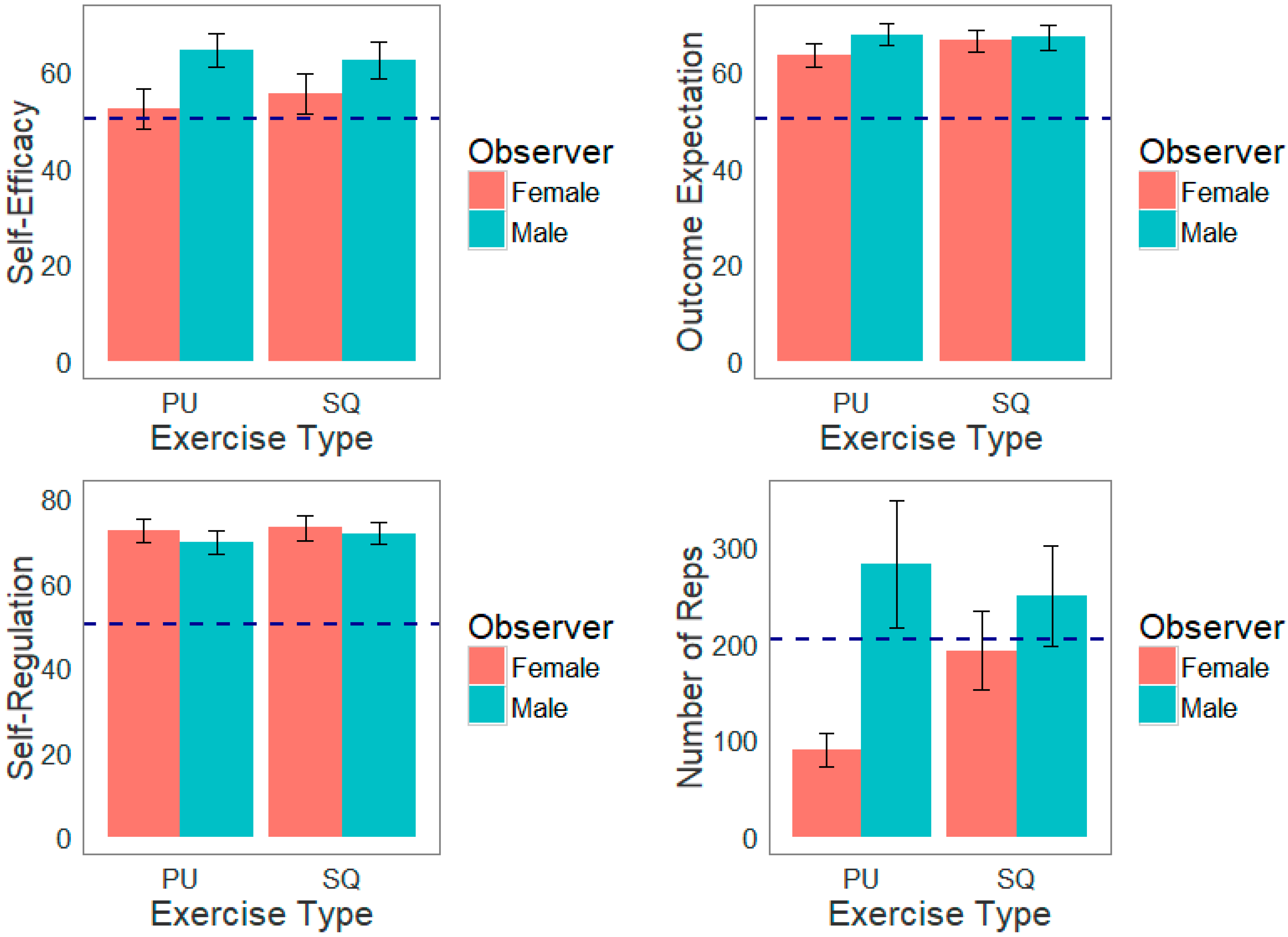
| Number | Percent | ||||
|---|---|---|---|---|---|
| Criterion | Subgroup | Male | Female | Male | Female |
| Age | 18–24 | 70 | 56 | 11.1 | 8.9 |
| 25–34 | 157 | 139 | 25.1 | 22.1 | |
| 35–34 | 76 | 79 | 12.1 | 12.6 | |
| 45–54 | 22 | 38 | 3.5 | 6.0 | |
| 54+ | 17 | 15 | 2.7 | 2.4 | |
| Education | Technical/trade school | 39 | 47 | 6.2 | 7.5 |
| High school | 70 | 66 | 11.1 | 10.5 | |
| B.Sc. | 162 | 154 | 25.8 | 24.5 | |
| M.Sc. | 54 | 42 | 8.6 | 6.7 | |
| Ph.D. | 6 | 9 | 1.0 | 1.4 | |
| Others | 11 | 9 | 1.7 | 1.4 | |
| Country of origin | Canada | 110 | 104 | 17.5 | 16.5 |
| United States | 184 | 194 | 29.3 | 30.8 | |
| Others | 51 | 26 | 8.1 | 4.1 | |
| Years on the Internet | 0–3 | 2 | 2 | 0.3 | 0.3 |
| 4–6 | 13 | 18 | 2.1 | 2.9 | |
| 7–9 | 40 | 20 | 6.4 | 3.2 | |
| 10+ | 287 | 287 | 45.6 | 45.6 | |
| Behavior model distribution | BM-PU | 45 | 50 | 7.2 | 7.9 |
| BF-PU | 39 | 43 | 6.2 | 6.8 | |
| WM-PU | 47 | 39 | 7.5 | 6.2 | |
| WF-PU | 44 | 39 | 7.0 | 6.2 | |
| BM-SQ | 42 | 46 | 6.7 | 7.3 | |
| BF-SQ | 46 | 25 | 7.3 | 4.0 | |
| WM-SQ | 41 | 42 | 6.5 | 6.7 | |
| WF-SQ | 38 | 43 | 6.0 | 6.8 | |
| Criterion | Overall Question and Items |
|---|---|
| Projected exercise performance level | Please kindly watch the [name of exercise] video and answer the questions below. Assume you were to perform this exercise at home throughout the week. (1) What average number of [name of exercise] do you think you can do per day? (2) How many days per week do you think you can do the [name of exercise]? |
| Self-efficacy [0—not confident to 100—confident] [18] | Please kindly watch the [name of exercise] video and answer the questions below. (1) How confident are you that you can complete at home the proposed weekly number of [name of exercise] (entered previously) for the next 3 months (a) Even when you have worries and problems? (b) Even if you feel depressed? (c) Even when you feel tense? (d) Even when you are tired? (e) Even when you are busy? (2) Please kindly give the reason behind your overall confidence level to perform the above workout. |
| Expectation outcome [1—strongly disagree to 5—strongly agree] [22] | Please kindly watch the [name of exercise] video and answer the questions below. (1) The [name of exercise] will… (a) Improve my ability to perform daily activities. (b) Improve my overall body functioning. (c) Strengthen my bones. (d) Increase my muscle strength. (e) Improve the functioning of my cardiovascular system. (f) Improve my social standing. (g) Make me more at ease with people. (h) Increase my acceptance by others. (2) Please kindly give the reason behind your overall rating above. |
| Self-regulation [1—strongly disagree to 5—strongly agree] [7] | Please kindly watch the [name of exercise] video and answer the questions below. (1) To achieve my proposed weekly average number of [name of exercise]. (a) I will set a goal. (b) I will develop a series of steps to reach my weekly goal. (c) I will keep track of my progress in meeting my goal. (d) I will endeavor to achieve the set goal for myself. (e) I will make the goal public by telling others about it. (2) Please kindly give the reason behind your overall rating above. |
| Target exercise-type Preference | (1) Please tell us your most preferred work out (physical activity) among the 12 shown above [see Figure 2]. (2) Please give the reason for the choice of your most preferred workout. (3) Please tell us your least preferred work out (physical activity) among the 12 shown above. (4) Please give the reason behind the choice of your least preferred workout. |
| Target Exercise-Type | Most Preferred (% Participants) | Least Preferred (% Participants) | Overall Preference (% Participants) | |||
|---|---|---|---|---|---|---|
| Male | Female | Male | Female | Male | Female | |
| Push-up | 34.80 | 3.36 | 7.60 | 20.49 | +27.19 | −17.13 |
| Squat | 12.28 | 18.65 | 4.09 | 3.67 | +8.19 | +14.98 |
| Crunch | 11.40 | 15.60 | 6.14 | 5.81 | +5.26 | +9.79 |
| Plank | 11.11 | 13.76 | 7.31 | 8.87 | +3.80 | +4.89 |
| Chair dip | 4.68 | 0.92 | 2.92 | 4.89 | +1.75 | −3.98 |
| Jumping jack | 5.85 | 14.68 | 11.70 | 7.65 | −5.85 | +7.03 |
| Push-up and rotate | 0.58 | 1.22 | 6.14 | 12.54 | −5.56 | −11.31 |
| Lunge | 4.97 | 6.73 | 5.26 | 5.81 | −0.29 | +0.92 |
| Wall sit | 1.75 | 4.59 | 10.23 | 4.89 | −8.48 | −0.31 |
| Run in place | 4.39 | 8.26 | 19.59 | 9.79 | −15.20 | −1.53 |
| Side plank | 0.29 | 1.22 | 6.73 | 10.09 | −6.43 | −8.87 |
| Step up | 3.80 | 9.17 | 9.94 | 3.67 | −6.14 | +5.50 |
| Others | 4.09 | 1.83 | 2.34 | 1.83 | +1.75 | 0.00 |
| Total % | 100.00 | 100.00 | 100.00 | 100.00 | 0.00 | 0.00 |
© 2020 by the authors. Licensee MDPI, Basel, Switzerland. This article is an open access article distributed under the terms and conditions of the Creative Commons Attribution (CC BY) license (http://creativecommons.org/licenses/by/4.0/).
Share and Cite
Oyibo, K.; Vassileva, J. Gender Preference and Difference in Behavior Modeling in Fitness Applications: A Mixed-Method Approach. Multimodal Technol. Interact. 2020, 4, 21. https://doi.org/10.3390/mti4020021
Oyibo K, Vassileva J. Gender Preference and Difference in Behavior Modeling in Fitness Applications: A Mixed-Method Approach. Multimodal Technologies and Interaction. 2020; 4(2):21. https://doi.org/10.3390/mti4020021
Chicago/Turabian StyleOyibo, Kiemute, and Julita Vassileva. 2020. "Gender Preference and Difference in Behavior Modeling in Fitness Applications: A Mixed-Method Approach" Multimodal Technologies and Interaction 4, no. 2: 21. https://doi.org/10.3390/mti4020021
APA StyleOyibo, K., & Vassileva, J. (2020). Gender Preference and Difference in Behavior Modeling in Fitness Applications: A Mixed-Method Approach. Multimodal Technologies and Interaction, 4(2), 21. https://doi.org/10.3390/mti4020021





